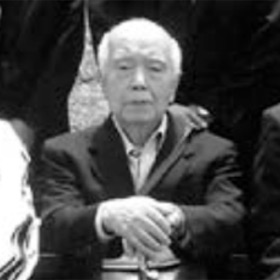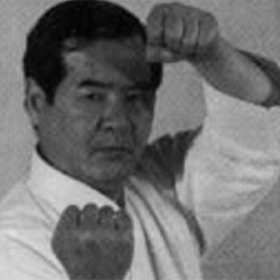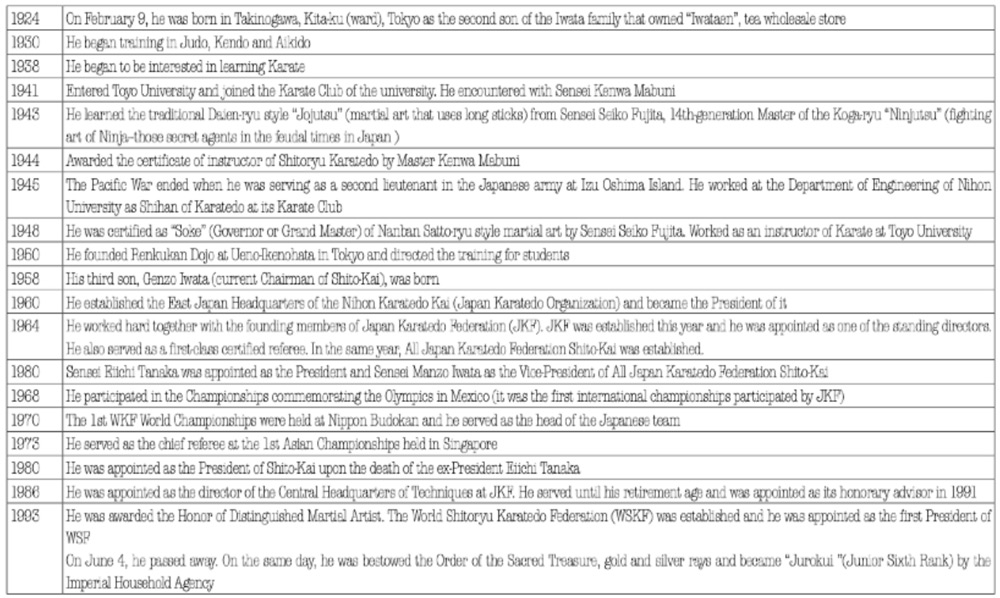Your cart is currently empty!

Sensei Kenwa Mabuni was born in Shuri City, Okinawa, on November 14, 1889. The origin of the Mabuni family comes from the name lord of the ancient Ryukyu Kingodom in Okinawa. There was a warlord called “0ni- Ohgushiku” in the old times. Sensei Kenwa Mabuni is one of his descendants, presumably the 17th generation grandson of this name warlord. Kenwa was a weak boy in his early childhood. Strangely he started feeling that he should be much stronger with sound and muscled body. Then he was allowed to enter the school of training when he was around 13 years old. He became one of the students of Master Anko Itosu who was living and teaching the martial art in Shuri City, Okinawa.
Graduating from his junior high school and the school of fisheries, he started teaching as an assistant teacher at Naha Elementary School for a while. He got acquainted with Sensei Chojun Miyagi, master of martial art and this acquaintance led him to Master Kanryo Higaonna who was versed in “Naha-Te” (Naha Karate).
After finishing his military service in 1914, he was recruited by the Naha Police Department and worked at the detective section for about 10 years. He had many opportunities of visiting local areas on job. It is how he met with the opportunities of learning Karate of “Arakaki” style, “boh-jutsu” (art of fighting with a cudgel), and “sai-jutsu” (art of fighting with metal truncheons) of “Tawata” style. They are parts of the old martial arts in Okinawa.
In May 1918, Kenwa Mabuni founded his “Karate Learning Group” and many trained practitioners of Karate gathered under him. In April 1921 he had the honor of demonstrating his art of Karate to the members for the Imperial Family of Japan when Princes (Kuni-nomiya and Kacho-no-miya) visited Okinawa. In 1924, he was asked to work as the teacher of Karate at Prefectural School of Fisheries and the training school for policemen. In the same year, he had another honor of demonstrating his art of Karate for the members of the Imperial Family of Japan when Princes (Chichibu-no-miya and Takamatsu-no-miya) visited Okinawa.
In April 1925, he established his Dojo at his house and founded the “Karate Learning Club”. Many leaders of Karate were there. You can name Chojun Miyagi, Juhatsu Kyoda, Choyu Motobu, Chomo Hanashiro, Chosho Ohgusuku, Choshin Chibana, and Go Kenki (Wu Xian Gui). In October 1926, Kenwa Mabuni had an extraordinary opportunity of meeting with Jigoro Kano, founder of modern Judo when he visited Okinawa. This founder of “Kodokan” Judo came and visited Okinawa for official speeches and for establishing the organization of Danholders of Judo in Okinawa. Sensei Mabuni and Sensei iyagi had the luxury of demonstrating and explaining about their art of Karate to this founder of Judo.
In 1929, Kenwa Mabuni moved to Osaka in the mainland Japan and he tried to popularize Karate (or Karatedo) among many universities in the western district of Japan. In 1931, he had the opportunity of demonstrating the art of Karate in the precinct of Sumiyoshi Shrine. In 1934, he established the “Yoshukan Karate Dojo”.
By then, many people knew and accepted the depth and the breadth of the knowledge and skills of Kenwa Mabuni. He was amazingly enthusiastic about accepting good elements of skills and techniques of Karate and studying the whole of its art by taking every new finding as part of good nourishment of his Karate style. In 1939, the “Shitoryu Karatedo” was founded. Kenwa Mabuni combined the features of Shuri Karate of Master Itosu and Naha Karate of Master Higaon-na. The name “Shito-ryu” (now Shitoryu) was formed from the first hieroglyphs of these Masters names (“ito” is “shi” and “higashi” is “to” in old Chinese hieroglyphs). In the same year, Kenwa Mabuni was awarded the honor of “Renshi” (the highest rank) of Karatedo from Dai Nippon Butoku- Kai.
Founder Kenwa Mabuni inherited the spirit of the Itosu style of Karate as its mainstream and tried to develop and popularize his “Shitoryu Karatedo” throughout his life.
He left his “tanka” (traditional Japanese poem) facing his death. It goes as follows:
“I have forgotten everything. It has been so pleasant to row a boat straight all along heading for the island of martial art”
He passed away at his own house on May 23, 1952 at the age of 62. His posthumous Buddhist name is “Yoshuin-Ken-Oh-Dogi-Kyoshi”.
2.The Way Kenwa Mabuni Learned Karate and How His Karate Paved Its Way
-Learning Karate from Sensei Anko Itosu, Kanryo Higaon-na and Yasukichi Arakaki
Kenwa Mabuni heard that a famous master of Karate was living in Shuri, Okinawa when he was about 13 years old. It was Sensei Anko Itosu. Through the introduction of his friend, he was allowed to learn under this master.
When Kenwa Mabuni was 20 years old, he started learning Karate under Sensei Kanryo Higaon-na through the introduction of Sensei Chojun Miyagi, his senior of Karate-learning. Under Sensei Higaon-na, Kenwa started learning “Shuri-Te” (Shuri Karate). Kenwa Mabuni and Chojun Miyagi were admired as two major and outstanding students of the school under Master Higaon-na.
When Sensei Mabuni was still working at the Police Station, he had many opportunities of visiting many places, and he learned many Kata and techniques other than “Shuri-Te” and “Naha-Te” under various Masters in local areas. At the same time, he learned “Saijutu” (the art of fighting with metal truncheon) under Sensei Shinpachi Tawada, and learned “Bojutsu of Soeishi style” under Sensei Soeishi, He also learned Karate and the traditional martial art such as “Bojutsu” (the art of fighting with a cudgel) under Sensei Arakaki ,
-Founder Kenwa Mabuni Established His Karate Learning Group
In 1918, Kenwa Mabuni established his Karate Learning Group. He had the honor of demonstrating the art of Karate in front of the Imperial Family of Japan (Princes Kuni-nomiya and Kacho-no-miya) when they visited Okinawa. In October 1925, his titanic effort to popularize Karate led him to the establishment of the “Okinawa Karate Learning Club”. It was the first Karate Dojo in Okinawa.
The leaders of this first Karate Dojo were Juhatsu Kyoda, Chojun Miyagi, Choyu Motobu, Chomo Hanashiro, Chosho Oshiro, Choshin Chibana, and Go Kenki (Wu Xian Gui), master of the Chinese-Kenpo (old martial art). In this Dojo, chief instructors were fairly young at age. They were Kenwa Mabuni and Chojun Miyagi.
-Kenwa Mabuni Demonstrated the Art of Karate to Jigoro Kano,Founder of Modern Judo in Japan, and then He
Moved to the Mainland Japan
In 1927, Kenwa Mabuni and Chojun Miyagi had the opportunity of demonstrating the art of Karate for Jigoro Kano, founder of modern Kodokan Judo, when he visited Okinawa. Looking at this demonstration, Sensei Kano, who was obviously astonished by the fine way of demonstration, said this. “This is good for both offense and defense. Why don’t you popularize it throughout Japan?” Hearing it, Kenwa Mabuni decided to move to the mainland Japan. It was in 1929.
-The Way Kenwa Mabuni Named His Style as “Shitoryu”
After moving to Osaka from Okinawa, Kenwa Mabuni established the Karate Learning Group in Kansai region (West Japan) . At the beginning, he named his style as “Gojuryu” and he was busy trying to popularize it. In 1934, however, he decided to rename his style of Karate as “Shitoryu”. This name was formed from the first hieroglyphs of two of his seniors— Sensei Itosu and Sensei Higaon-na. It is how the name “Shitoryu” was born. In 1931, the Karate Learning Group in Kansai region was renamed as “Dai Nippon Karatedo Kai” (All Japan Karatedo Organization).
Then the art of Shitoryu began spreading among students of Karate all around Japan.
-The Only Martial Art that Survived the Prohibition Law of the Martial Arts in Japan Imposed by the Occupied US Army General Headquarters after the 2nd World War
When Japan surrendered to the United States in August 1945, everything changed. The US Army headquarters that occupied Japan then under the leadership of General MacArthur banned the practice of most of the old Japanese martial arts. The only one that survived is Karate. It was the only martial art that stayed as part of education in Japan. Then many Karate Clubs started activating among universities.
Those who mastered the martial arts in Japan, including Judo and Kendo, came and joined the practice of Karate. Thus Karate became the source of their mentality.
In 1934, Kenwa Mabuni renamed his Dojo in Osaka as “Yoshukan” after the name of the junior high school he graduated from. In 1950, US Army’s prohibition law of the Japanese martial arts was lifted and all these martial arts in Japan were reshaped and reorganized as modern sports.
Successors of the Founder (Brief Sketches of their Careers)
1.Sensei Ken-ei Mabuni

Career

-My Memories of My Father, Kenwa Mabuni
As far as I remember what was going on in my house in Okinawa in my childhood, I was starting to learn Karate by just watching people practicing it. There was a Dojo at the back of our house then. I witnessed many goods for training, such as sheaved straws, iron clogs, bellybands and sanders. Many students of my father were doing their practice there. It was the “Okinawa Karate Learning Club” itself and our house was its Dojo. In those days, the first priority of Karate was to build our own basic physical strength.
As for the skills and techniques, all the students of my father were trying to learn them by themselves by practicing Kumite. When they asked my father for guidance, he told them to come and fight with him. He said to them, “Come and do it with me”. My father was letting his students to do “Tsuki” (frontal thrust) and “Keri” (kicking) freely and it was his way of instructing them. It was the same with the way of his instructing Kata for his students. I guess that his students have found their own respective ways of understanding and interpreting what my father instructed them. How these students took what my father taught and instructed them was depending upon many different physiques, characters and ways of thinking of them. My father, Kenwa Mabuni, never forced any of his students to do this and that. He rather seemed to have enjoyed them learn more from what they individually tried to find for themselves.
I myself was never told to practice Karate by my father. Having two elder sisters, I might have been indulged in my childhood. It is true, however, that I started practicing Karate in a very natural way by myself.
After moving to Osaka from Okinawa, my father sometimes demonstrated Karate at the Dojo of the Police Station. When he demonstrated the breaking of roof tiles and boards, some called what my father did as the “Fist Dance”. So it was rather dangerous to show the power of Karate of this kind to the audience at the Police Station. Probably they might have thought that Karate is not suited for policemen. So it seemed quite difficult for my father to try to popularize Karate among people in those days.
I remember the strong wills and enthusiasm of the students who gathered around my father. I also remember how my father devoted almost half of his life to the development and popularization of Karate. These memories make me motivated even today. I strongly believe that it is my duty to pass on what my father found and created, namely, Shitoryu Karatedo itself, to the coming generation in good manners.
2.Sensei Manzo Iwata

Career

-My Recollection of Founder Kenwa Mabuni (excerpts from the book “Kunshi-no-Ken” – “Fists of Man of Virtue” )
The first thing I recall of Master Kenwa Mabuni is his gentle and modest character. In those days, it was hard to find an instructor like him. He was always modest in trying to learn whatever he did not know from anyone. He was always ready to obtain any knowledge to broaden his way of learning and thinking.
As a result, he was able to learn many Kata on one hand. On the other, he was always enthusiastic about pursuing something new. He was the first one to include “bunkai kumite”, which no other instructor of any style was trying to adopt, in his system of learning. He actually defined the meaning of each Kata and established the classic ways to make the most of each Kata. It was his way of transmitting everything he has learned to the coming younger generation.
Master Kenwa Mabuni was very vigorous and coherent in trying to teach us students the cores of Waza (skills) and Kata (forms). He thoroughly tried to teach us everything he has learned. He patiently waited until we could grasp the essence of this art. He was always coherent in his way of teaching us the differences and the features of Itosu style and Higaonna style. He was not adding anything new to what he has learned. He was stubborn in teaching us the traditional classic Waza (skills).
At the same time, Master Mabuni urged me to absorb a lot of knowledge and skills and kindly introduced me to Master Seiko Fujita, one of Master Mabuni’s friends and master of many traditional Japanese martial arts, to learn something more. Everything I learned under Master Fujita is valuable for me and my life. Now I feel so indebted and thankful for what Master Mabuni suggested me to try doing.
Now I know that the core of Master Mabuni’s heart is being inherited among us as refined and sophisticated skills of Shitoryu. When I recall Master Mabuni, I cannot help but truthfully get to know the importance of transmitting and telling the classic cores of Shitoryu Karatedo to the coming generations.
